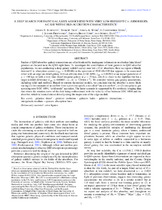| dc.contributor.author | Burchett, Joseph N. | |
| dc.contributor.author | Tripp, Todd M. | |
| dc.contributor.author | Werk, Jessica K. | |
| dc.contributor.author | Howk, J. Christopher | |
| dc.contributor.author | Dave, Romeel | |
| dc.contributor.author | Prochaska, J. Xavier | |
| dc.contributor.author | Ford, Amanda Brady | |
| dc.date.accessioned | 2016-04-13T21:19:01Z | |
| dc.date.available | 2016-04-13T21:19:01Z | |
| dc.date.issued | 2013 | |
| dc.identifier.citation | Burchett, J.N. et al. (2013). A deep search for faint galaxies associated with very low-redshift C iv absorbers: A case with cold-accretion characteristics. Astrophysical Journal Letters, 779:L7 | en_US |
| dc.identifier.issn | 2041-8205 | |
| dc.identifier.uri | http://hdl.handle.net/10566/2115 | |
| dc.description.abstract | Studies of QSO absorber–galaxy connections are often hindered by inadequate information on whether faint/dwarf
galaxies are located near the QSO sight lines. To investigate the contribution of faint galaxies to QSO absorber
populations, we are conducting a deep galaxy redshift survey near low-z Civ absorbers. Here we report a blindly
detected C iv absorption system (zabs = 0.00348) in the spectrum of PG1148+549 that appears to be associated
either with an edge-on dwarf galaxy with an obvious disk (UGC 6894, zgal = 0.00283) at an impact parameter of
ρ = 190 kpc or with a very faint dwarf irregular galaxy at ρ = 23 kpc, which is closer to the sightline but has a
larger redshift difference (zgal = 0.00107, i.e., δv = 724 km s−1). We consider various gas/galaxy associations,
including infall and outflows. Based on current theoretical models, we conclude that the absorber is most likely
tracing (1) the remnants of an outflow from a previous epoch, a so-called “ancient outflow”, or (2) intergalactic gas
accreting onto UGC 6894, “cold mode” accretion. The latter scenario is supported by Hi synthesis imaging data
that shows the rotation curve of the disk being codirectional with the velocity offset between UGC 6894 and the
absorber, which is located almost directly along the major axis of the edge-on disk. | en_US |
| dc.language.iso | en | en_US |
| dc.publisher | The American Astronomical Society | en_US |
| dc.rights | AAS grants back to authors the non-exclusive right of republication, subject only to giving appropriate credit to the journal in which the article was published. This non-exclusive right of republication gives authors the right to approve or deny reproduction of all or part of the article and to post the final published version online. | |
| dc.source.uri | http://dx.doi.org.za/10.1088/2041-8205/779/2/L17 | |
| dc.subject | Galaxies | en_US |
| dc.subject | Galaxies evolution | en_US |
| dc.subject | Dwarf | en_US |
| dc.subject | Intergalactic medium | en_US |
| dc.subject | Quasars | en_US |
| dc.title | A deep search for faint galaxies associated with very low-redshift C iv absorbers: A case with cold-accretion characteristics | en_US |
| dc.type | Article | en_US |
| dc.privacy.showsubmitter | false | |
| dc.status.ispeerreviewed | true | |
| dc.description.accreditation | Web of Science | en_US |

